Two days ago, there was only one Trumpeter Swan swimming off of Kokanee Creek Park. Today there were two.
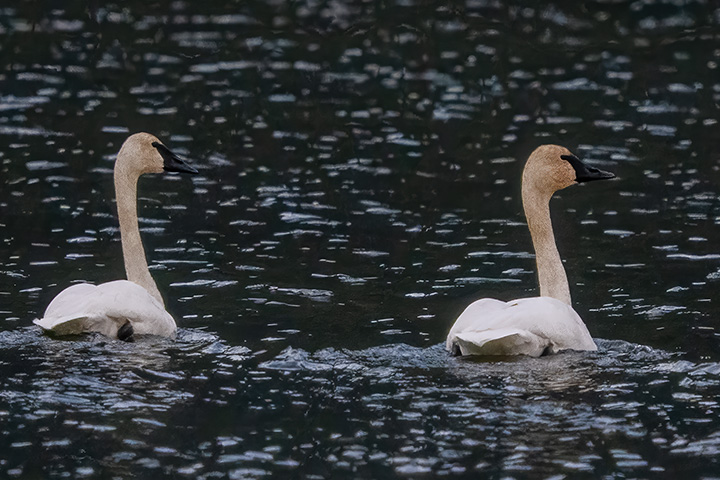
Two days ago, there was only one Trumpeter Swan swimming off of Kokanee Creek Park. Today there were two.

Years ago, I saw mainly Tundra Swans around the west arm of Kootenay Lake. Now I see mainly Trumpeter Swans here.
Indeed, there have been Trumpeters here for the last few days, although when I looked this morning, there was only one to be seen. Nevertheless, we can expect to see swans here for a few months before they head north.
A Trumpeter Swan was seen at Kokanee Creek Park this morning.
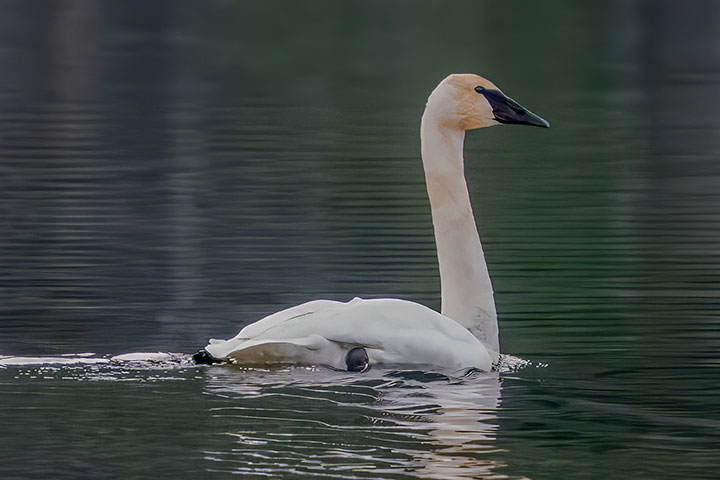
Last weekend, around the south end of Kootenay Lake, about 3 dozen Tundra and Trumpeter Swans spent time feeding and flying around. Here is one group of the Tundra Swans having a spat. Photo by Cynthia Fraser
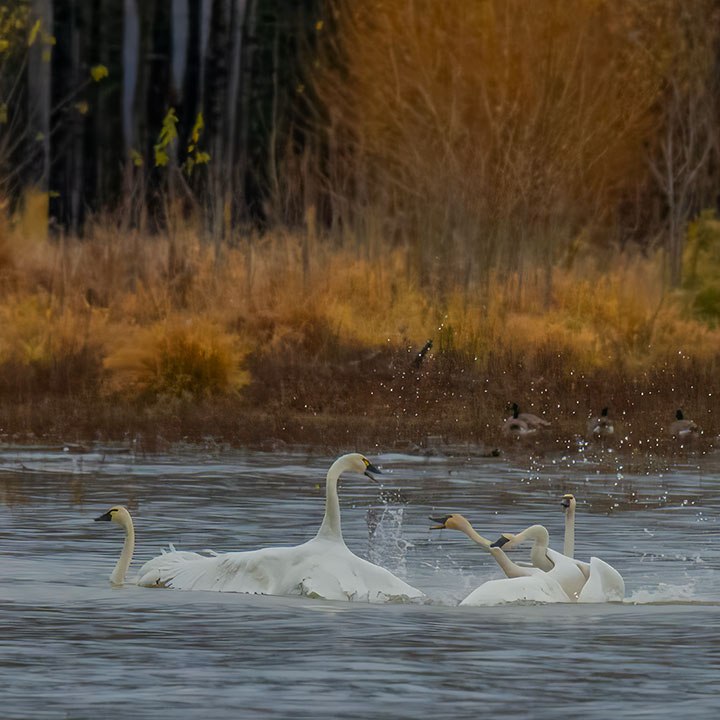
Sometime ago I commented that the occasions where Wild Turkeys display is during the spring mating season. This was in response to advertisers who regularly showed Wild Turkeys in full display in the fall.
However, the number of Wild Turkeys seen locally has increased markedly since I offered that remark, and so I have had the opportunity to observe them much more. Recently, I have regularly seen the males in full display at many times of the year, including in the fall. It turns out that while the springtime mating is the primary impetus for a display, their mating does not provide the only reason for doing so. Males will also display at any time of the year when trying to assert their dominance over other males.
A male Wild Turkey climbs on a fence and displays to others saying, I am dominant.

The first two items deal with white-tailed deer and fencing (not fighting with swords), but the last item does show fighting, but in play.
Fences can serve a number of different purposes, but one of them is to keep domestic animals confined. Another is to prevent wildlife from accessing a region. The first two pictures suggest that these fences have questionable wildlife functionality.
A female white-tailed deer easily jumps over a wire-mesh fence. These fences seem to be primarily developed to keep domestic animals in, not wild animals out. Photo by Cynthia.
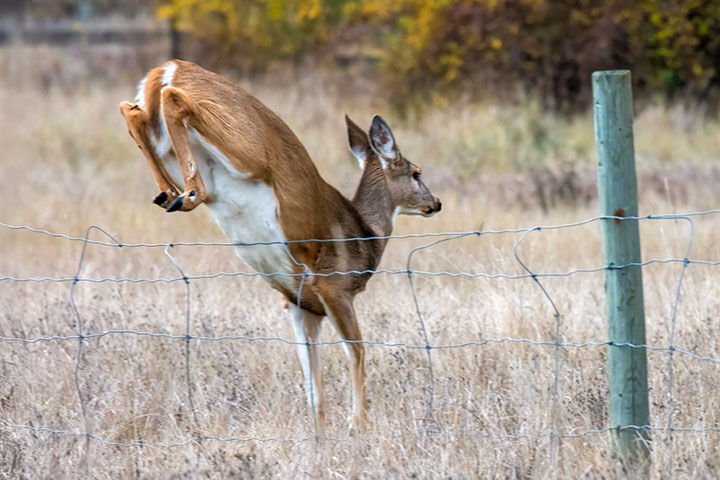
A male white-tailed deer climbs under a simple rail fence, but the fence confines horses.
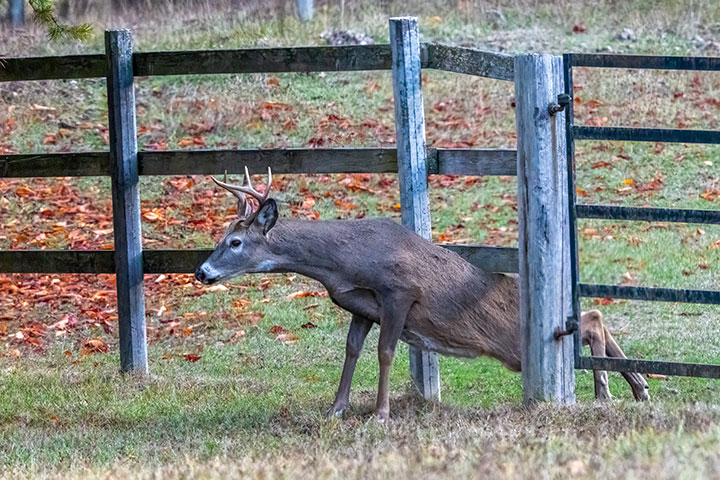
A portrait of the same 2½ year-old deer.
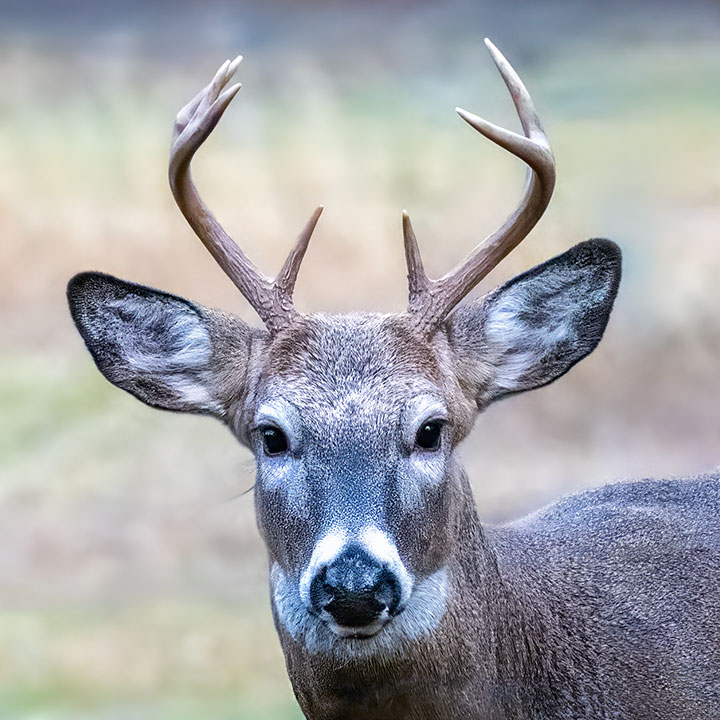
Here are three whitetail spikehorns (1½ years old). Two of them are play fighting and one has his head down. Male whitetails always seem to fight antler to antler. This is quite unlike the female whitetails shown earlier who stood up and brandished their forelimbs.
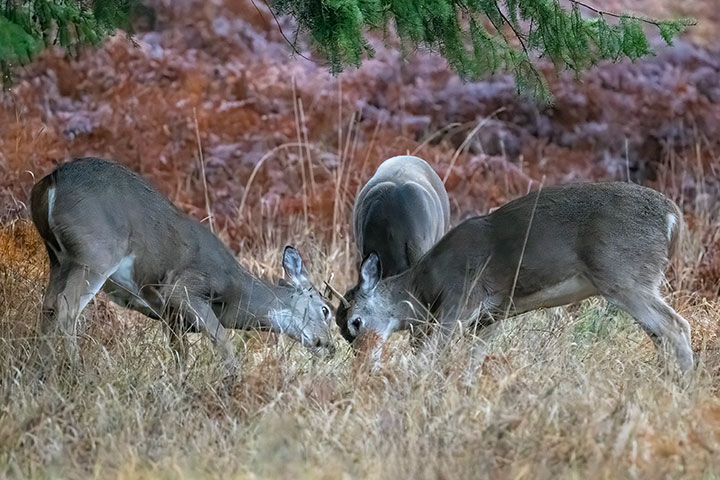
Two females stand on hind legs. They are beginning to spar for dominance.

I had always assumed that female white-tailed deer were fairly docile. Despite being really common around here, I had never seen them fight — never, that is, until yesterday. To my considerable surprise, I watched two females rise up on their hind legs and brandish one another with their forelimbs.
Their ears were held out horizontally in a form of threat, and their tails were extended horizontally indicating that each felt she was (or should be) dominant.
They each were presumably sparring for the dominant position in the herd. The event lasted for under five seconds where the forelegs were waved up and down, but never seemed to make contact with the other deer. It was all an exercise in intimidation, and one of them soon gave up and ran away, thus leaving the position of dominance to the other.
It is unclear whether the females of the other deer species around here (mule deer, elk, caribou, moose) similarly battle for dominance. This happens much too rarely for me to have seen it and I have found no reference to them fighting each other.
There follows some pictures of the combat.
To start, here is a detail of the above picture of them starting their combat.
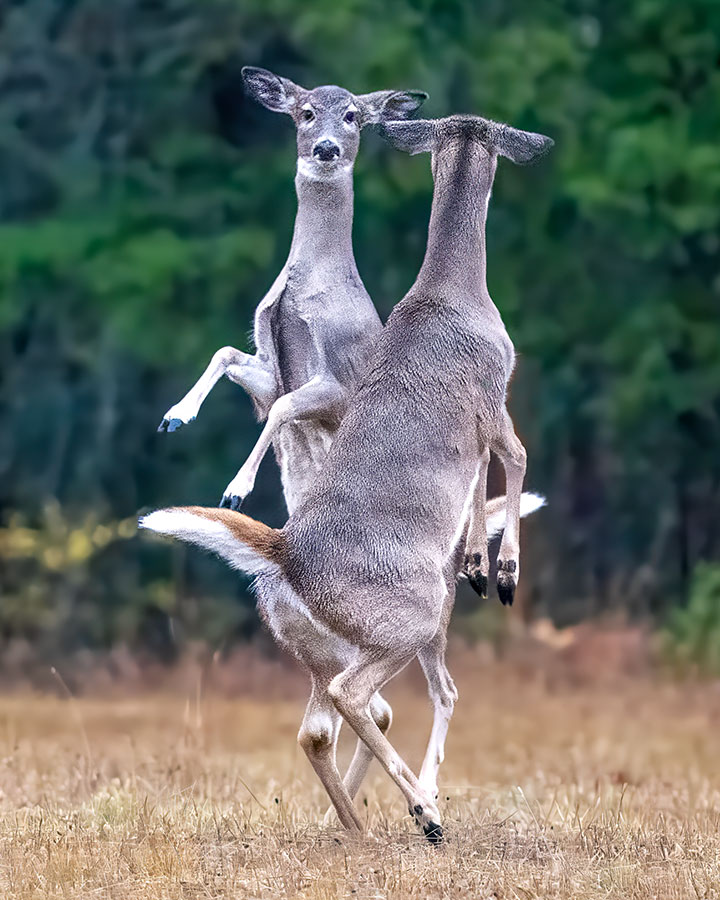
The two combatants faced each other and pawed the air in front of themselves. The facing deer has one foreleg up and the other down but she quickly switched their positions again and again. The deer with its back to us has both forelegs up.

The deer with its back to us is beginning to accept defeat. Its ears, that had expressed a threat, are dropping, and its tail, claiming dominance, is down. Its adversary, facing us, is carrying on with gusto.
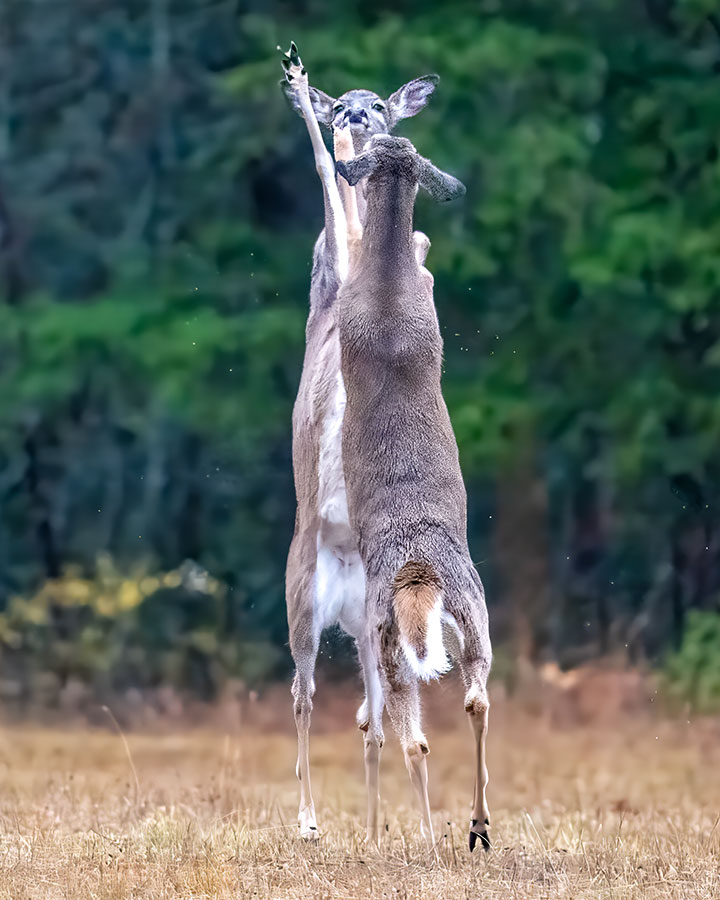
The deer, that had its back to us, gives up the fight and runs away.
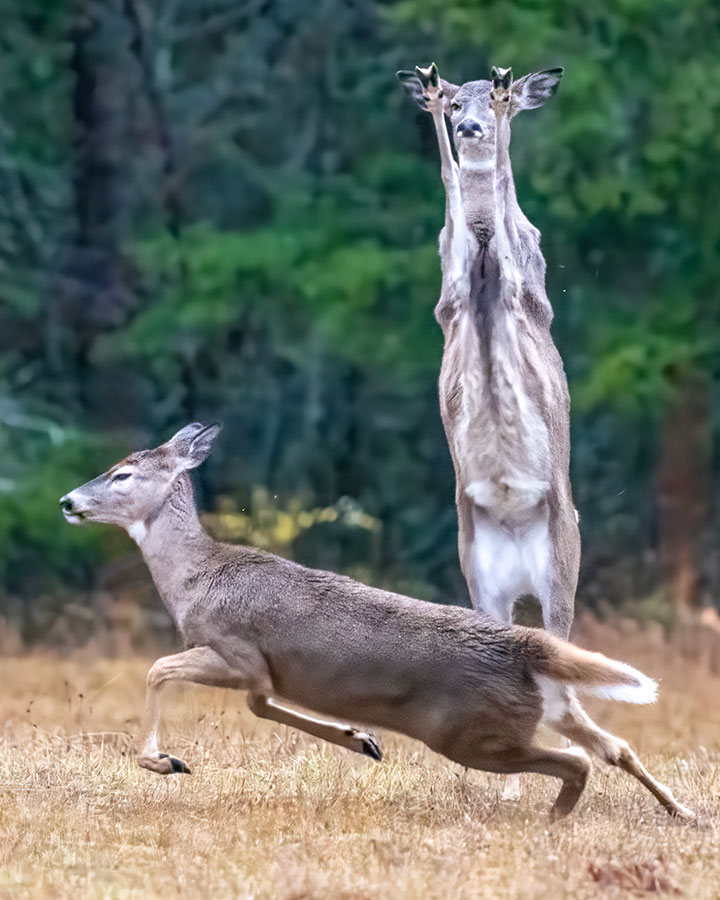
The event was over quickly. At no time previously have I seen female white-tailed deer act this way. They can be more combative than I ever suspected.
Last Saturday morning was a remarkably good day for watching birds eat berries from trees. While even more birds were seen on that walk, shown are those that ate. Eating berries is clearly seasonal.
A late-season Cedar Waxwing is about to eat a blue elderberry. Photo by Cynthia Fraser.
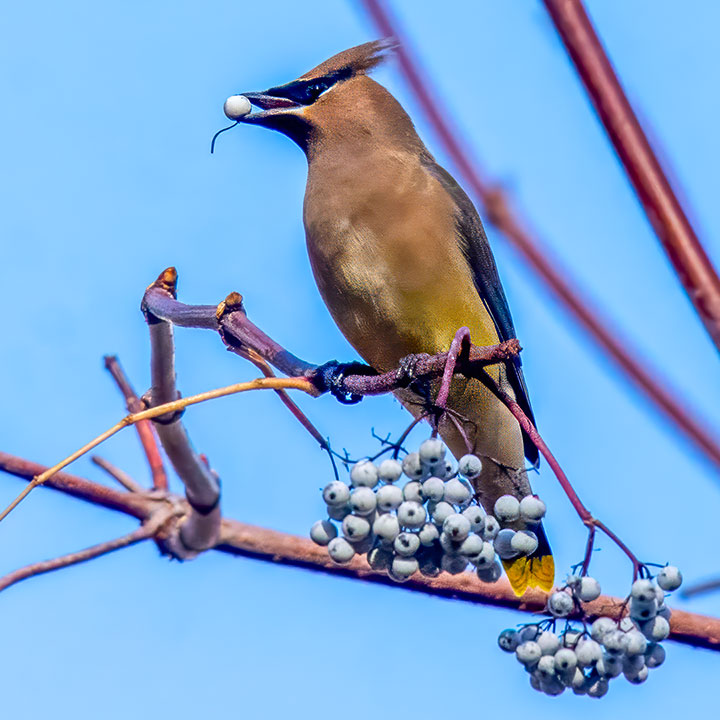
Merely spotting a Downy Woodpecker makes for a good walk. Photo by Cynthia.

But watching it eat is better. Here it spreads its wing and leans down to get a berry.
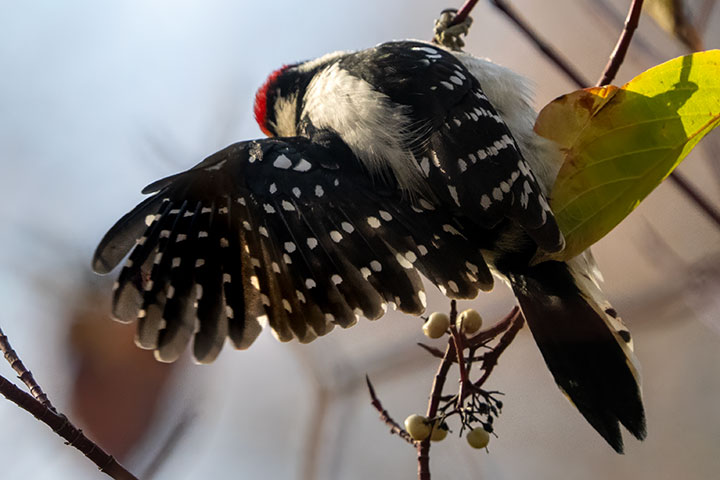
The Downy Woodpecker picks a snowberry.
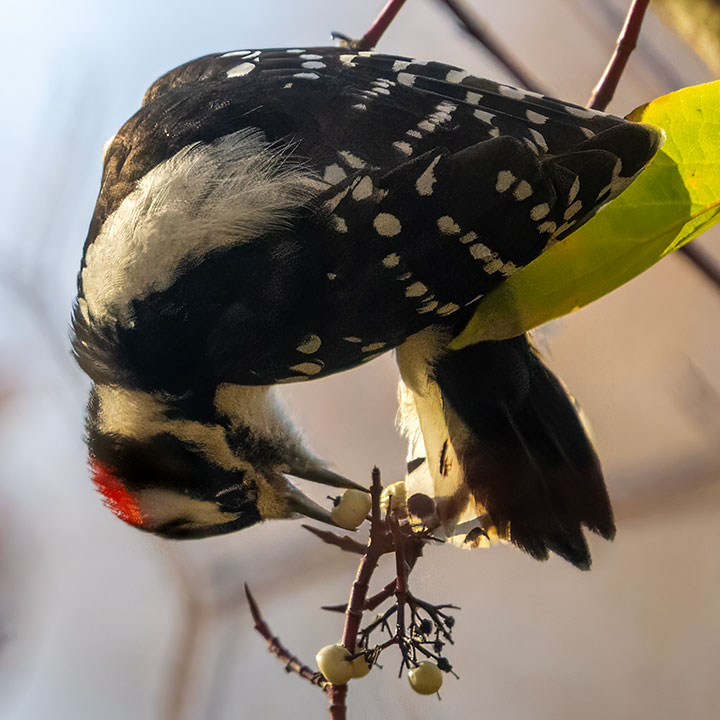
But, the nicest transient shot is that of a Crow and blue elderberry.

Squirrels cannot reach our bird feeder. Yet, birds can be sloppy eaters and frequently cause their food, black-oil sunflower seeds, to fall to the deck below. A resourceful squirrel can fetch one and spirit it away to one of its winter storehouses. Each day, the squirrel scampers back and forth between a storage place and beneath the bird feeder. Always, the squirrel carries but one seed at a time. It seems like endless work, but presumably it will pay off when there is snow on the ground.
A squirrel finds a black-oil sunflower seed. Beside it is the empty shell of a previous one.
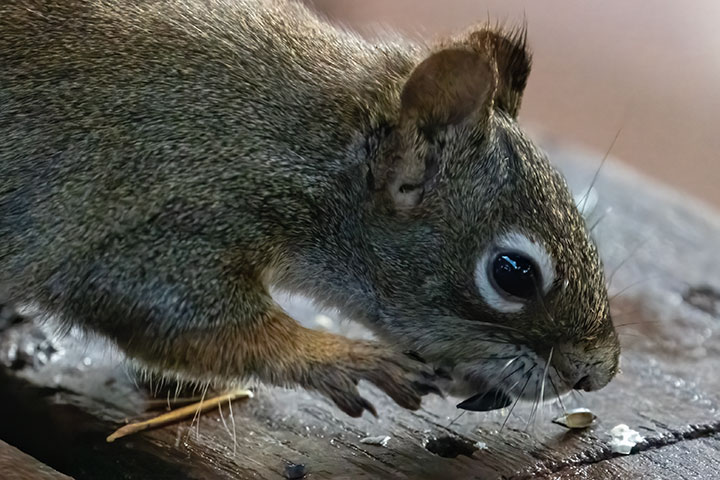
The squirrel holds the oilseed. The shell casing is falling to the left.

Then putting the seed in its mouth, it rushes off to add the seed to its provisions. Strangely, the squirrel alway starts on its way first by leaping. 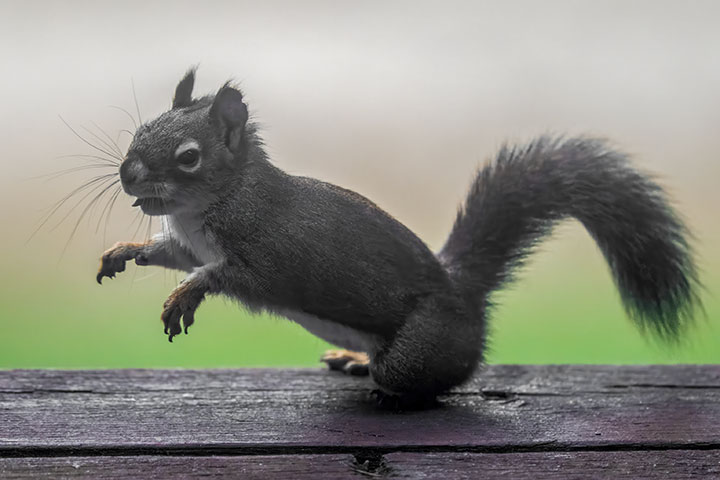
The Horned Lark is a widespread bird across the world’s grasslands, but is uncommon here, presumably owing to our heavy forestation. I have seen it only a few times before, but a pattern is beginning to emerge.
I have always seen it here in its non-breading plumage, so it is lacking the male’s feather tufts that gave it the name of horned. The monthly timing and the short stays suggest that it is not a permanent resident, but is migrating through this area.
A pair of Horned Larks (female top and slightly larger, male bottom) stops by to feed.
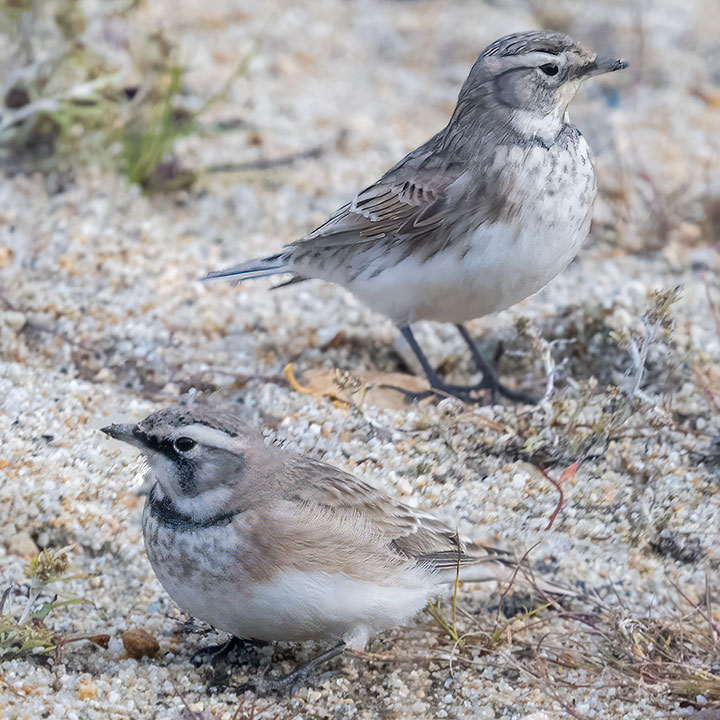
Unlike the grizzly bears seen a week ago, black bears often come into town in the fall. It is there that black bears might find food to fatten up before they enter torpor. On this occasion, a sow and two cubs were not scrounging garbage, but feasting on walnuts.
One can often see them with their mouths open almost as if they were huffing at their watchers. They were were not huffing. While occasionally noticing the people drifting by, even those taking pictures, they were just chewing walnuts and spitting out the shells.
Chosen pictures often show their eyes as if they often would look our way. This is not the case for, while aware of people nearby, they seemed just largely to ignore watchers.
This is the mother bear munching. She is quite large, having fed extensively before torpor.
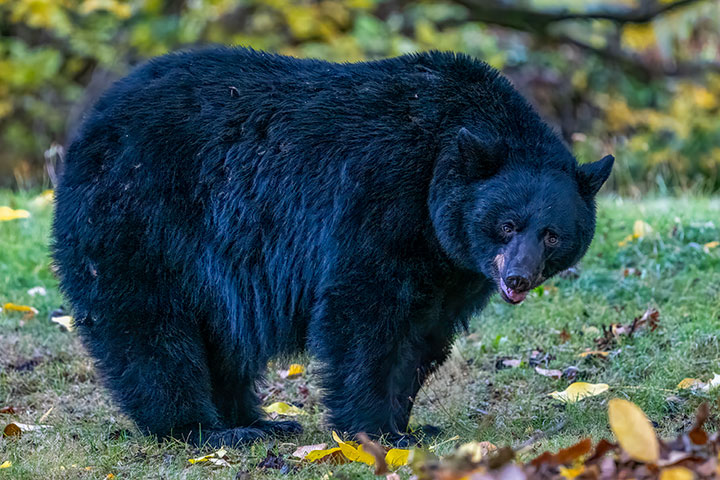
Here are the three of them. The two cubs are eating (one with a walnut in its mouth), while the mother watches.
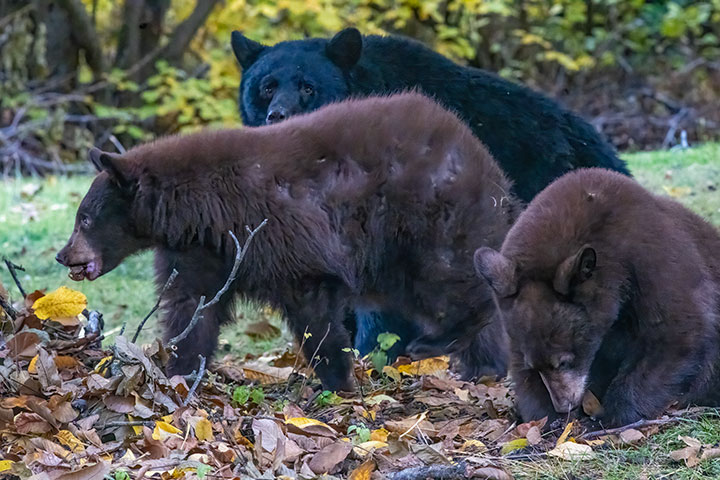
A cub sits in the tree. Photo by Dorothy.
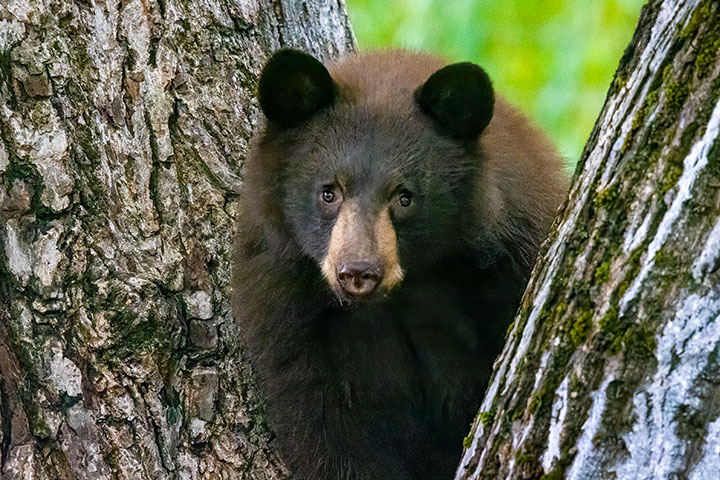
The sow and cub up the walnut tree and there to sleep for a while. Photo by Cynthia.

A cub is now descending the walnut tree.
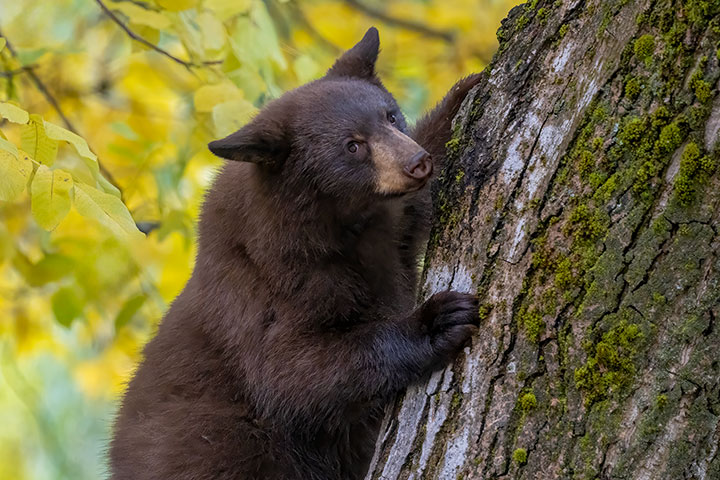
The mother and one of the cubs. Both are chewing walnuts.
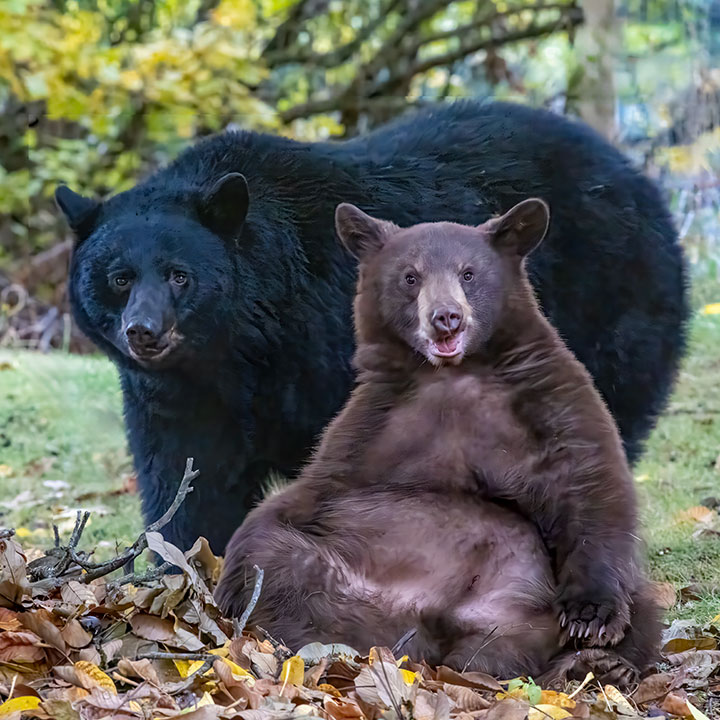
In the fall, bears eat a great deal in anticipation of spending the winter hibernating — well, they do not actually hibernate but have a somewhat lighter sleeping state called torpor. At a fish-bearing stream, bears will eat nearly continuously in anticipation of the forthcoming long torpor. For bears, a river of Kokanee spawning provides a smorgasbord.
These two grizzlies are a mother and her young cub. When together, the sow is clearly larger than the cub, but when seen alone, it is often difficult to tell which is which.
The two grizzlies were sometimes affectionate toward each other. The sow is on the left with her back towards us and the cub is on the right facing us. Some time ago, the sow sustained an injury on her right rear hip where the fur has regrown. Photo by Cynthia.
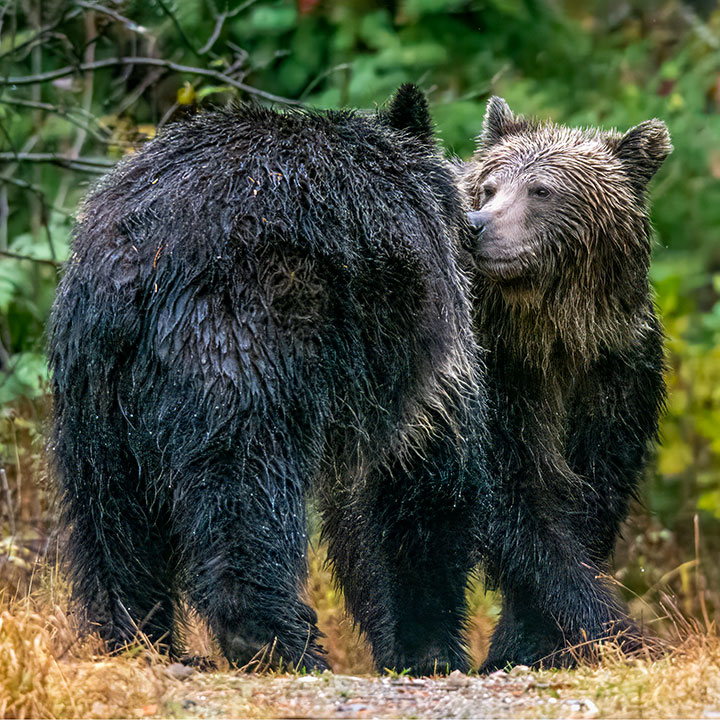
The grizzlies were continually catching and eating the Kokanee in the river.
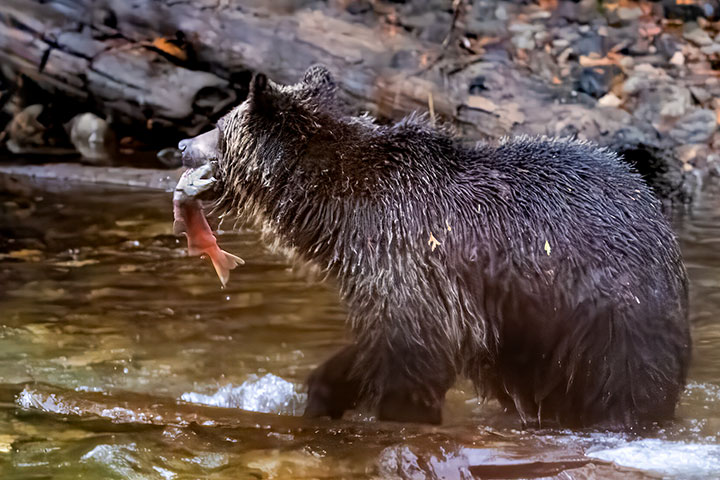
When not eating, the bears would hunt or move to a new spot.
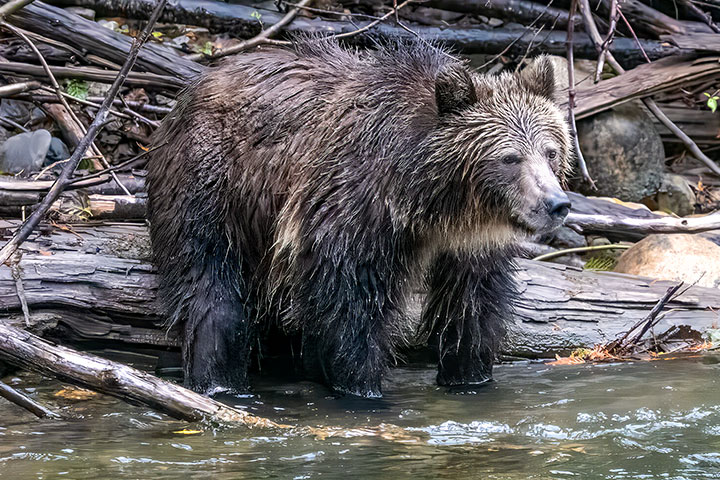
The grizzly moves a Kokanee to the land to eat it.
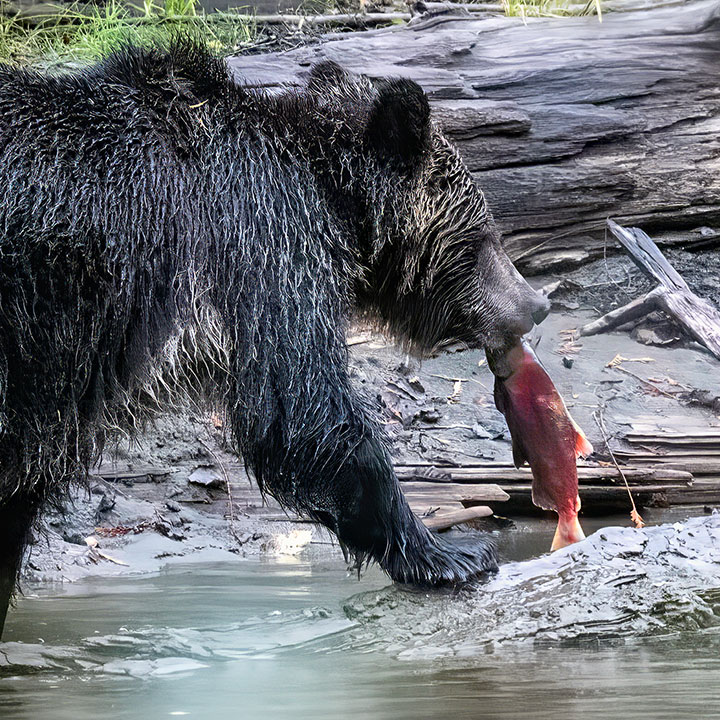
The cub works on a Kokanee. Note the fish’s eye below the bear’s paw.

Sometimes eating in the water produces lots of splashing. Photo by Cynthia.
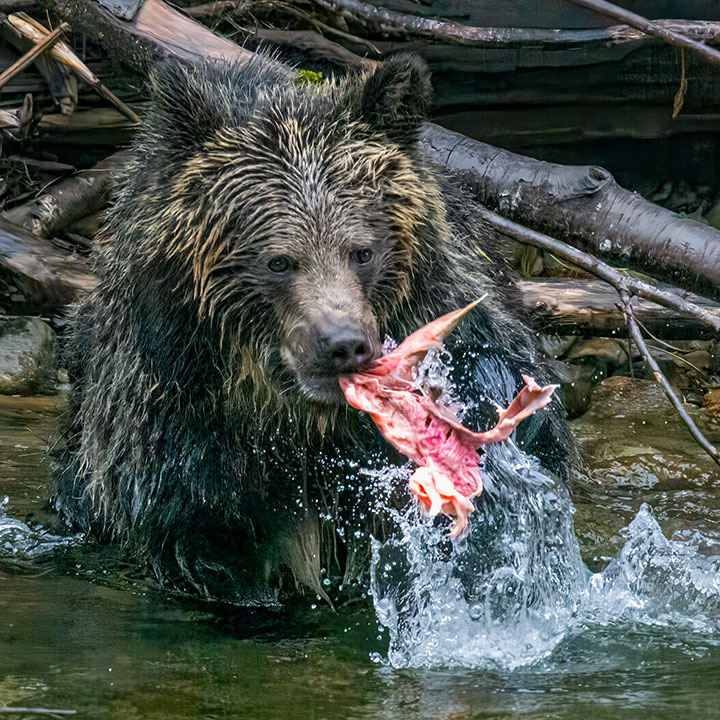
The two grizzlies were never far apart, but rarely close enough to be in the same picture. The sow is on the log, while the cub, with a catch, has its back to us. Photo by Cynthia.
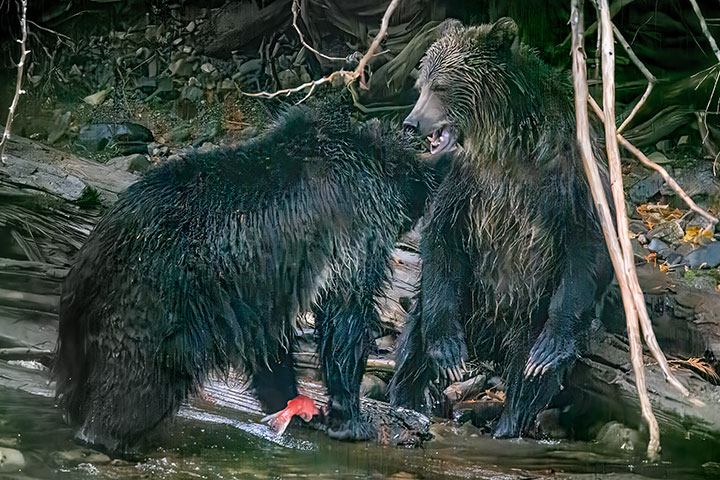
Together: the sow is on the left and the cub is on the right.
